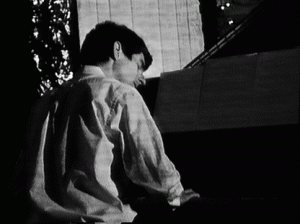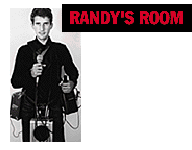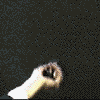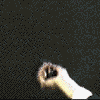James Randolph “Randy” Hostetler
July 28, 1963 – Feb. 1, 1996
James Randolph “Randy” Hostetler was born July 28, 1963 in Washington, D.C. and died in Los Angeles on February 1, l996 at the age of 32 of natural causes, most probably of undiagnosed Addison’s Disease.
Randy Hostetler composed more than fifty works in his short lifetime, including scores for chamber orchestra, solo and combined instruments, chorus, film, tape, found objects and ambient sounds. His text work for overlapping voices, “Happily Ever After” which was released on cd by Frogpeak in 1999 has been widely acclaimed as one of the best electronic works of the 20th century. The Princeton composer Paul Lansky wrote that “It was unlike anything I had ever heard and it immediately changed my view of what music is and can be.” A shorter version of “Happily” was published on cd by Perspectives of New Music in 1988, and the complete piece was broadcast on Carl Stone’s public radio program of new music around the same time.
“Deep,” an improvisational work for wind instruments and tape of a sleeping person’s snoring sounds, was performed by the California Ear Unit on its Denmark tour and rebroadcast on Danish Public Radio in l997. The Talujon Quartet and several members of the Philip Glass Ensemble in 1998 headlined a New York MATA festival performance of Hostetler’s chamber orchestra work, “P[L]ACES,” which was composed while he was a student at CalArts.
Hostetler’s iconic piece for piano and billiard ball, “8” was written at CalArts for Mel Powell and its performance at Powell’s public birthday celebration concert was hailed by the L.A. Times’ critics as “hilariously gimmicky” and a highlight of the concert. The brief work requires the pianist to play the piano and juggle a billiard ball at the same time. It was performed by New York pianist, Jenny Lin, at New York’s Le Poisson Rouge in 2010 and also received its Canadian premiere with Ms. Lin at the Winnipeg Symphony Festival of New Music the same year. Ms. Lin’s performance, as well as one in the studio by Hostetler himself, can be seen on YouTube. In January 2010 the composer’s string quartet, “Palm Quart,” with a score consisting of a video of Palm Trees videographed in Los Angeles by Francesca Talenti, was performed at Walt Disney Concert Hall’s Redcat Theater in Los Angeles. A saxophone quartet work, “Twenty Five Years” that was composed by Hostetler while he was an undergraduate at Yale to commemorate the 25th wedding anniversary of Mary and Larry Hewes who commissioned the work was performed again by the Washington Saxophone Quartet in 2010.
A gifted musician from birth, Randy Hostetler began taking piano lessons at the age of eight at the American University’s preparatory department in Washington and completed his first composition, a minuet in the style of Mozart, before he was nine. His many early compositions included a twelve tone piece, “World War III”, composed when he was eleven, a violin sonata when he was twelve, and a piece for prepared piano when he was thirteen. He attended high school at the Sidwell Friends School in Washington and composed several choral pieces for its chamber chorus and orchestral students. He also organized a barbershop singing quartet and played jazz piano with a jazz combo of fellow students that was heard on the local affiliate of Pacifica Radio.
Randy Hostetler attended Yale University from 1981 to 1985, majoring and graduating with honors in music. While at Yale, he continued to study piano and to compose. His teachers and mentors included Martin Bresnick and Frederic Rzewski, and he enthusiastically participated in “Sheep’s Clothing” a Dadaist performance organization created by Martin Bresnick. He helped organize with his roommate, David Edelson (now David Tolchinsky) an experimental band, “Institutional Quality.” He also sang with Yale’s first coed singing group, “Redhot and Blue”, became its director (“pitch”) in l984 and arranged several pieces of music for the group, most notably, Gershwin’s “Summertime,” and Monk’s “Round Midnight” which arrangements continue to be sung by the group today and can be heard on YouTube. At Yale’s graduation in 1985, Hostetler was awarded Yale’s Friends of Music prize as the class’s most promising composer, particularly for his chamber orchestra work, “Big Mac.”
After graduation from Yale, and a year living in Boston, Randy Hostetler entered the master’s program in music at the California Institute of the Arts in l986 where he studied composition with Mel Powell, Paul Lansky and Morton Subotnick. He graduated with an MFA in music in l989 and continued to live in the Silver Lake and then Echo Park neighborhoods of Los Angeles. In l990 he was invited to participate in June in Buffalo’s summer program, and in subsequent years received a recording grant from New York’s Harvest Works and several ASCAP awards.
While living in Los Angeles, Randy Hostetler established and curated the Living Room Series, a bi-monthly concert of new music from 1989-1993 that attracted scores of musicians from Los Angeles, the San Francisco bay area and even from further away. The composers Michael Fink, Frederic Rzewski, Steve Horowitz and Arthur Jarvinen were among the participating performers. The series included what is thought to be the first live Los Angeles performance of Erik Satie’s “Vexations,” an event that lasted twenty four hours and included more than two dozen pianists, including the United Kingdom’s Christopher Hobbs. Hostetler also began to study and perform performance art with Sten Rudstrom, Ernie Lafky, Mike Bell and others.
Randy Hostetler was known by his fellow artists as an intellectual “composer’s composer,” but he was beloved for his puckish sense of humor, for his wildly enthusiastic love of all sounds, for all things “Cagean,” for his embrace of experimental musical and multi-media works, as well as for improvisational works, and for his unstinting support of other artists. Stories about Randy Hostetler and his often hilarious performances continue to be told. For example, among his memorable concerts at CalArts was his third year concert in l989 that included his cajoling some of his fellow students into rolling his friend’s Honda into CalArts and on to the stage at the small ROD theater in the middle of the night so that the concert could begin the next day with him inside of the Honda “playing” the car in an original composition for wipers, horn and squeaky door. Former Yale students still recall his “Sheep’s Clothing” performance in which he led a small platoon of “performers” into the campus’s Sterling Library at a busy time of day for the library, positioning each of the performers by a card catalog cabinet until the signal came from him to begin a “percussion” work by opening and slamming the cabinet drawers.
“I thought he was one of the most talented people I have ever met, and someone who was bound to make an indelible mark on the culture of our country sooner or later. Certainly he was a key figure in the world of struggling Los Angeles artists. With him surely a part of our hopes for a renewal of the arts in America has vanished. We must carry on.”
– Frederic Rzewski
“Randy was not an eccentric composer (even though he wrote a piece using billiard balls to play a piano). He was just an honest composer. The work he did came directly from his perception of who he was, and what he wanted to say. We’re all the more fortunate because he was so good at expressing these things, and what he had to say was, and is, such a joy to hear.”
– Paul Lansky
“During his brief career Randy Hostetler accomplished a great deal. His catalogue includes over forty works in a wide range of media – instrumental solo and chamber works, vocal music, film music, tape music, intermedia works, experimental film and video, visual art and performance art. His Living Room Series provided an outlet for experimental composers, artists and performers in Los Angeles, often attracting participants from as far away as the Bay Area and Las Vegas.”
– Arthur Jarvinen
New Video Additions to Randy’s Room!
Randy performing “8”. Video by Zig Gron
Randy’s string quartet Palm Quart. Video by Francesca Talenti, posted on Youtube by Zig Gron
Randy’s string quartet Floaters. Posted on YouTube by Zig Gron
Randy conducting “Pilgrim’s Chorus” by Richard Wagner. Video by Zig Gron
Randy’s Work
- List of Works
- Dinner Map – performance piece
- Happily Ever After CD available from Frogpeak Music at a special price for friends who visit this site
- Reviews and Comments
- Article by Paul Lansky
- Clip from Happily Ever After
- Another Excerpt
Performances of Randy’s Work
- World Premiere of P[L]ACES
- Bielawa Reconstruction
- Historical Note
- An Appreciation
- A Second Appreciation
- RealAudio Excerpt of P[L]ACES
- About Rob Tate’s Document(ary) of P[L]ACES
Recollections
- Arthur Jarvinen’s 8 Stories
- The California Years
- The New Haven/Boston Years
- The Washington D.C. Years
- Family Remembrance
- Memorial Service in Los Angeles
- Ralph Nader column
- Pictures of Randy
“My memories are of how he loved to bring joy to others, but only if he could challenge and stimulate at the same time. Of his heroic refusal to pander or play down to an audience. Of his fearless improvisations, his intrepid walking bass lines, his howling, yelping scats, his impeccably timed and witty musical quotations, of “Ingredients” and his piece “for piano and 8 ball”. And of his physical portrayal of three-against-two rhythm: pivoting on his right foot, his torso rocking while his left leg pumped in opposition to his emphatic arms. He was three against two.
Randy had a wondrous appreciation for and sensitivity to life as art, as text as music. All sounds were music to him, from the blank of an old radiator starting up to the rhythm of a story well told. Randy found the extraordinary in the ordinary, the uncommon in the common. His was a gift that made those whom he touched more aware of the richness of their world by his willingness to share his.”
– Mark Heller
“He never heard noise, he heard only music”
– Kate Hostetler
Works for or Dedicated to Randy
- Francesca Talenti’s Snake Tales
- Auto Salvage/Elegy for Randy by Marc Lowenstein
- “Death’s Feather” – Steve Horowitz
- Arthur Jarvinen’s “Out of the Blue”
- Randy Poster by Tim Makepeace
- “Memorial to Randy” by Debra Tolchinsky
- A Sonnet by Ben Scotch
- An Ode from the Hewes Family
- A Poem from Sten Rudstrom
Links Related to Randy’s Life
“Whether bringing young struggling musicians together in his ‘Living Room’ every two months, or gardening and cooking with exotic herbs, practicing T’ai chi, reading Zen and Japanese poetry, composing and performing on the road, Hostetler was a whirling, eclectic, humorful, detailed, demanding work in progress….
But it seems that above all what attracted so many artists to Randy Hostetler was that always everywhere, he asked the impertinent questions of others and himself. He jolted them into imagination and examination.”
– Ralph Nader
Listen to Randy play Erik Satie

Randy’s Words
- A Post to the John Cage List
- A Letter To John Cage
- Interview with High School Newspaper
- Letters to Andrew Szanton
- Randy’s Dream About John Cage
- A Postcard to a friend regarding Merce Cunningham
- A Letter to Poet, Linda Pastan
- A Letter to a Friend Regarding Berio’s Folk Songs
- A Letter to Grandparents on Their 50th Wedding Anniversary
- Thoughts on death as a 24 year old
“A lot of people make a mistake in believing that improvisation, or the fact that the types of forms Randy chose, or the media that he chose weren’t always easily definable by traditional standards and that somehow that made him quirky or esoteric. Randy was brilliant. And there’s nothing that he approached that didn’t bring that brilliance to it.”
– Rick Applebaum



